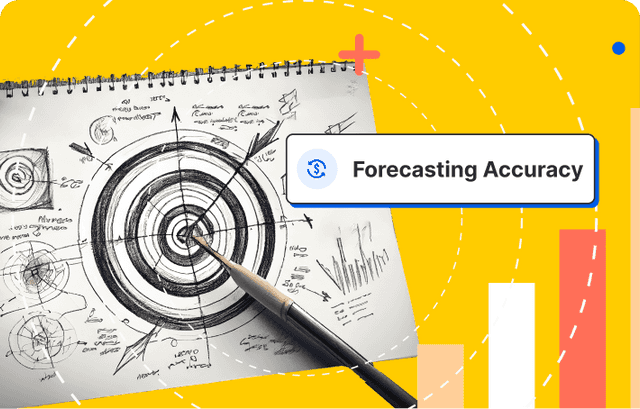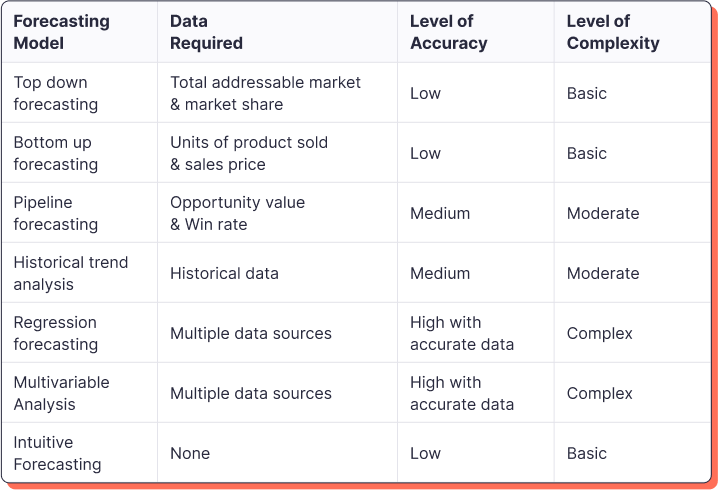6 Tips to Improve Sales Forecasting Accuracy

Co-Founder & CEO
As the bridge between sales, marketing, and finance teams, the Revenue Operations (RevOps) team is often tasked with improving sales forecasting accuracy. This can seem like a daunting, nebulous task—how do you predict the future?
Without a designated process in place to create your sales forecast, it can feel more like pulling numbers out of thin air rather than a data-driven strategy, especially when 68% of companies miss their forecast by more than 10%.
Fortunately, we have a number of tips and tools to help you strategically approach forecasting and accurately predict sales.

What Is Sales Forecasting and Why Does It Matter?
Sales forecasting is the process of estimating how much revenue will be brought in by sales teams or individual sales members over the course of a week, month, quarter, or year.
While it’s focused on the results of the sales team, the impact and financial benefits of an accurate sales forecast extend to all corners of the company. An accurate forecast gives RevOps teams insights into how teams are trending toward their quarterly goals and provides predictable revenue. The predictability gives companies more freedom to test out-of-the-box projects and is more likely to lead to revenue growth.
According to The Aberdeen Group, companies that perfect their sales forecasting are 10% more likely to grow annual revenue. And it makes sense—if you’re less worried about meeting your sales forecast each quarter, teams have time to focus on other projects that can move the needle.
Factors Affecting Sales Forecasting
There are a number of factors both external and internal to take into account when planning your sales forecasting and improving its accuracy. While it’s impossible to include every possible scenario in your forecast, take a look at the factors below and decide what may be most important to your company.
- Seasonality: Take into account your business’ busy season as well as its slump. For example, the travel industry usually sees an uptick in the summer and around holidays with slowdowns in the fall and spring. Review historical data to help you factor seasonality into the forecasting.
- Market changes: While it’s impossible to predict the market, understanding market trends and how those can impact your industry, the price and demand of your product, can be important measures to bake into your forecast.
- Economic conditions: Inflation, recession, increasing interest rates can all affect your sales forecast. Consider how the current economic conditions may affect your forecast.
- Employee turnover: Employee hiring and turnover can have a significant impact on sales forecast. Whether the team is hiring new sales reps or letting go of the sales reps that aren’t meeting quota, understanding the on and off boarding of new members can be helpful in estimating sales.
- New products: Product launches and new features can affect sales forecasting, driving interest and additional sales for your company’s products.
- Legislative changes: When GDPR first arrived on the scene, many businesses had to pivot their marketing tactics, leading to a reduced number of qualified leads. If there’s legislation on the horizon that could impact your business, consider incorporating it into your sales forecast.
Measuring Sales Forecast Accuracy
Sales forecast accuracy measures how well you forecasted your sales for the quarter or year and how accurate your sales expectations are.
For example, if you sold $90,000 in Q3, but forecasted $100,000, your forecast accuracy is 90%.
While the goal is to get as close to 100% as possible, the likelihood of that happening is slim. Typically forecast accuracy breaks down as follows:
Great: Within 5% above or below forecast
Okay: Within 10% above or below forecast
Terrible: More than 10% above or below forecast
If you’re not reaching within 10% of your sales forecast, you are overestimating or underestimating your sales. Overestimating sales forecasts can lead to unnecessary expenditures that put your company at risk of budget cuts and, in extreme cases, layoffs.
Underestimating your forecast and exceeding your sales goals may not seem like a bad thing, but if it happens consistently, there is predictable revenue that you can earmark for additional hires or marketing budget. This can prevent your company from growing at a faster rate.
Below, we’ll cover a number of tips to help you improve sales forecast accuracy for your company.
How to Improve Sales Forecast Accuracy
1. Define Your Metrics
If you haven’t already, it’s time to define the path your customer takes to purchase in collaboration with marketing and sales teams. This process begins with an agreed upon definition for a lead that shows interest in your company’s offerings. From there, it’s important to understand the number of stages the lead goes through (interest, consideration, budgeting, purchase, etc.). And, finally, you’ll need to determine the definition of a sales qualified lead and how that relates to the marketing team.
Without these foundational elements in place, teams will be marching toward disjointed goals that lead to miscommunication, tension among teams, and, you guessed it—inaccurate sales forecasts.

2. Keep Your Data Clean
Arguably the most important aspect to improve sales forecasting accuracy is working with accurate data. Working with clean, comprehensive data gives you the peace of mind that you’re making educated, data-backed decisions.
Take a look at your CRM. Do you have partial or missing data? A misalignment of definitions? Or no data at all? If you answered yes to any of those questions, it’s time to do a deep clean.
A few best practices for a clean CRM are to:
- Remove duplicate records
- Standardize data formats and fields
- Provide a training session on CRM usage
Many teams are likely using the CRM, so it’s important to provide regular training and reminders for all teams to keep the CRM data clean.
For more data hygiene best practices, check out Sightfull’s article on CRM data hygiene.
3. Align Data Across Teams
Your teams need to not only talk to one another but speak the same language. Once the process has been agreed upon by marketing and sales teams and the data has been cleaned, it’s time to align your data under one source of truth.
Your company likely has data in a variety of locations from marketing analytics software like Marketo, your CRM, such as Salesforce, and finance software like Looker. All of these platforms are looking at data in slightly different ways.
That’s where a revenue analytics platform like Sightfull comes in. Sightfull integrates with all of your existing tools to align data across your Go-to-Market teams. This way you're measuring success off of the same reports, speaking the same language, and charging toward the same goals.
With a single source of truth for your data, you’ll be well on your way to improving sales forecast accuracy.
Discover the likelihood of winning opportunities.

4. Choose the Right Sales Forecasting Method
The right method can improve the accuracy of your sales forecast. But before choosing a forecasting method, ask yourself the following questions:
- How much sales data do you have? A quarter, year, multiple years?
- How accurate is your historical data?
- How much time and resources do you have to invest in your forecasting methodology and to keep it updated?
With those answers in mind, take a look at the following forecasting methods to decide which is the best for your company.
Top-down forecasting
Top-down forecasting first evaluates external factors like the state of the market and competitive landscape to determine the revenue a company can achieve. The goal is to evaluate the total addressable market and the potential market share your company will be able to capture to then estimate revenue.
Bottom-up forecasting
Meanwhile, bottom-up forecasting starts with the details that you already have. It looks at historical data, such as previous marketing and sales performance, current budgets, and existing customers to predict sales.
Pipeline forecasting
As the name suggests, pipeline forecasting uses the sales team’s current sales pipeline to predict future sales for the company. The pipeline forecasting model predicts future revenue by using the estimated opportunity value of each deal as well as the sales rep’s win rate. This forecasting method is data-intensive and requires at least a few months of pipeline data to predict future growth.
Historical trend analysis
Historical forecasting is something that all companies should review to understand the company’s sales cycle and use it as a baseline to predict how much a company will sell during a given period. Historical forecasting is only somewhat accurate because there are anomalies each year that affect your company’s sales. For that reason, historical forecasting should be paired with other forecasting methodologies.
Regression forecasting
A regression model is a form of statistical modeling that helps teams understand which sales activities affect how many deals are closed. Or, in technical terms, what independent variables are affecting dependent variables. Regression forecasting utilizes complex mathematical equations, so CRM software and/or revenue analysis software is needed to help with the calculations.
Multivariable analysis
This analysis uses a combination of forecasting methods, including historical forecasting, and sales data such as sales cycle, opportunity stage, and rep win rates.
While this forecasting model is very comprehensive, pulling in multiple forecasting methods, it is incredibly data-heavy, making it more complex and resource-intensive. If your company does not have reliable data or your company does not have the time and resources to spend building out a multivariable analysis, then this is not the forecasting method for you.
Intuitive forecasting
Intuitive forecasting relies on the sales reps and what the reps believe they’ll be able to close for the forecasting period. This method is not based on quantifiable data, only the reps’ estimates. This is not a reliable method for forecasting and is only employed when companies are just getting off the ground. In that case, the company has very little data to base forecasts and can use the reps’ expertise to help estimate sales.

Start with a simple forecasting model
While it can be tempting to select one of the more complex forecasting models, it’s better to start simple and add on as you go. The more complex forecasting models may be more accurate, but only if you have the data to support it as well as time and resources to continually update the models.
If your company is just getting started and you have no data or very little at your disposal, then use one of the basic forecasting models to start. As you get more data and resources, you can move into the moderate and complex forecasting models to improve the accuracy of your forecasts.
5. Leverage Forecasting Technology
While it is still an option to forecast via an Excel spreadsheet, there are fortunately a number of tools that can make accurate sales forecasting a lot easier.
AI & machine learning: Tools that are powered by AI can review historical data and provide insights into common patterns, improving the accuracy of your sales forecasts.
Revenue analytics tools: Platforms like Sightfull provide companies with a holistic view of their revenue, making it easier to forecast sales and manage sales pipeline. By integrating with the tools that you already have, Sightfull pulls in data across Go-to-Market teams to give you the big picture and drill into the details. Sightfull has pre-created templates that make it easy for you to plug in your data for you to get insights within seconds.
Check out a few of the forecasting-related templates below:
Pipeline Waterfall
Opportunity Management
Pipeline Analysis
Sales Funnel
6. Get Feedback from the Sales Team
Your sales team knows the ins and outs of the sales process and can be a helpful resource as you refine and improve sales forecasting at your company. Including the sales reps in the process also helps make them accountable and feel greater ownership over the numbers within the forecast.
As you meet with them, reiterate the importance of an up-to-date CRM with information that is accurately added. If it isn’t updated regularly, it can greatly affect your forecasting.
Sales Forecasting Simplified with Sightfull
Improving sales forecasting accuracy will be an ongoing mission that requires regular review and updates to your forecasting model. You’ll need to balance the data-driven insights alongside the feedback from your sales team and external factors in the market.
But, it doesn’t need to be a daunting process. With Sightfull, you can easily track your sales forecasts and see if you're on target to reach those predictions. Share the dashboards with sales and marketing teams as well as executives to make sure everyone is on the same page.
Talk to an expert
Get insights for data-driven decision making and growth
Sales Forecasting Accuracy
Use our Pipeline Waterfall Template to optimize your pipeline management with ease
